In this Article:
In this article, we are going to look at two cartridges of the same bullet diameter that have very distinct differences in their performance. Though they are different, when looking at the .300 Win Mag vs the .308 Winchester, we see two effective cartridges that when used in the right scenario, will be successful hunt after hunt.
And that is why the goal of this article is not to pick one cartridge as the best; there are plenty of articles and forums out there endlessly debating the topic. Instead of throwing ourselves into a circular argument, we are going to look at the performance specs of these two cartridges so that we can have a better understanding of in which situation these cartridges will excel.
For two hunting cartridges with an impeccable track record such as these, they both deserve the recognition for their abilities in the field. So, let’s first take a look at the origins of these cartridges and how their design specifications match up.
A Brief History
.300 Winchester Magnum
The .300 Win Mag is a 30-cal bullet that came into production by Winchester in 1963. When comparing to other popular hunting rounds, the .300 Win Mag is a newcomer.
This cartridge can be packed with large amounts of powder giving it a huge advantage in velocity and in turn, the ability to carry a large amount of energy over a greater distance. The cartridge is also able to be to take a variety of bullet weights. Most weights are within the 150-200 grain range, but there are several lighter and heavier rounds available. It is also available in a wide array of bullet styles which gives it a lot of versatility. All of this has resulted in one of the most popular magnum cartridges in the modern sporting world.
This is an extremely popular cartridge for long-range shooters including those chasing big game. The .300 Win Mag is not only a hunting cartridge but is also favored by long-range competitive shooters. While this cartridge has been and is still used in sharpshooting corners of the military, the majority of its action is found in the hunting world.
.308 Winchester
The .308 Winchester is a cornerstone of the American hunting world, though it has a strong history in other shooting circles. The .308 was introduced by Winchester in 1952 where it gained an immediate following in the hunting community. Soon after, the military adopted the cartridge and modified it to produce the 7.62×51 NATO round to replace the .30-06 chambered rifles in Vietnam.
Even though widespread use of the .308 in the military was short-lived, it shows no sign of faltering in the hunting world. The larger weight bullets and casing provide a cartridge that can give excellent range for most hunting scenarios and provide more than enough stopping power for medium to large size game. And it is still found in military and police circles, just not to the extend as it was earlier in its lifetime.
This is a highly popular cartridge and is widely available with numerous options for bullet weights and designs which further increases its versatility in the field.
Specs
| .300 Win Mag | .308 Win | |
|---|---|---|
| Parent Casing | .375 H&H Magnum | .300 Savage |
| Bullet Diameter | 0.308†| 0.308†|
| Neck Diameter | 0.339†| 0.3433†|
| Base Diameter | 0.532†| 0.4709†|
| Case Length | 2.62†| 2.015†|
| Overall Length | 3.34†| 2.8†|
| Case Capacity | 93.8gr | 56gr |
| Max Pressure (SAAMI) | 64,000psi | 62,000psi |
If we take a look at the basic cartridge specs of these two cartridges, we can see some major differences. Both of these use the same diameter bullet, but we will see by looking at performance specs that these two cartridges do not behave similarly regardless of using the same caliber bullet. The major difference is in the case dimensions. The neck diameter of the two casings are slightly different with the .300 WM being a couple of hundredths of an inch smaller than the .308 Win. The .300 WM has a wider base diameter and a significantly longer case length than the .308 Win which results in a much more voluminous case that allows more powder and can take higher pressure than the .308 Win. This is where the differences we will see in the ballistics, and other performance categories originate.
To gain some insights into the .300 Win Mag vs .308 arguments, we have chosen five rounds of each cartridge for comparison. We will take a look at several ballistics categories such as the velocity and trajectory as well as other important characteristics such as stopping power and generated recoil. Again, our goal in doing this is not to determine which cartridge is better but in what situations each cartridge might be better suited.
Even with ten selected rounds, we acknowledge that this is still a small sample size compared to what is on the market. We are still confident that the conclusions we can reach give us a clear window into these two cartridges. We have selected five popular rounds that are most often used in the field so even though there are a lot more options out there, what matters for most marksmen and hunters is what is most available. Another reason we are confident is that we have selected a good range of available rounds with varying bullet weights and designs. We have listed these rounds below.
 .300 Win Mag Federal Vital-Shok Trophy Bonded 180gr
.300 Win Mag Federal Vital-Shok Trophy Bonded 180gr .300 Win Mag Federal MatchKing BTHP Gold Medal 190gr
.300 Win Mag Federal MatchKing BTHP Gold Medal 190gr .300 Win Mag Nosler Trophy Grade AccuBond Long Range 190gr
.300 Win Mag Nosler Trophy Grade AccuBond Long Range 190gr .300 Win Mag Barnes Precision Match OTM 220gr
.300 Win Mag Barnes Precision Match OTM 220gr .300 Win Mag Hornady Superformance SST 180gr
.300 Win Mag Hornady Superformance SST 180gr
 .308 Hornady BTHP Match 168gr
.308 Hornady BTHP Match 168gr .308 Winchester Super-X 180gr
.308 Winchester Super-X 180gr .308 Nosler Ballistic Tip 165gr
.308 Nosler Ballistic Tip 165gr .308 Federal Vital-Shok Ballistic Tip 150gr
.308 Federal Vital-Shok Ballistic Tip 150gr .308 Federal Gold Medal Sierra Matchking 175gr
.308 Federal Gold Medal Sierra Matchking 175gr
These ten rounds are all available factory loads that you can find and purchase at just about any major retail store. Your cartridge of choice might not be on this list, and that doesn’t mean that we don’t think it deserves to be or is an inferior cartridge in any way. In reality, we are just limited in space and had to draw a cutoff line.
While we think these rounds are a pretty fair representation of the two cartridges, we understand if some of you would be skeptical. Because of that, we actually compiled forty total factory loads, though we are not graphing them. We will present the averages for all of these rounds at the end of each section. We hope this gives you a little more confidence in the results and it should also back up our claim that the smaller samples are giving us accurate results. All of these rounds are listed at the end of the article.
All of the data that you are going to see in this article has been taken from the manufacturer’s website or generated from online ballistic generators. Because these are computer generated numbers, they may not be the exact numbers you would get from firing these rounds through your platform. This is common since just about every gun has its own ballistics profile. Because all of this data is computer generated, the trends in this article hold up to data generated in the field. It is also preferred for comparing cartridges because you do not have the variations from firing rounds live and measuring the various ballistic categories
So, let’s jump into the fun stuff.
Recoil
What we are going to look at for recoil is the actual force that is generated by igniting the powder within the cartridge. Sending bullets downrange at such high velocities that both of these cartridges achieve also generates a significant amount of force that we feel and call recoil or kick.
We can’t quantify the recoil you will feel when firing a rifle chambered for one of these cartridges. This is known as “felt recoil,” and a lot of other factors influence this such as barrel length and stock design. Because of this, we will stick to the measurable ft.lb force generated. It still gives you a good idea of the amount of kick you will have to deal with and is a good way to quantify recoil between two cartridges such as the .300 Win Mag vs the .308.
First, let’s look at a general comparison of recoil force between the .308 and .300 WM that was generated by the recoil calculator as an average of several rounds (Graph 1).
Both cartridges generate over 20ft.lbs of force, so they have significant kick. This amount of recoil is considered enough to cause flinching for a lot of shooters which is going to greatly influence your accuracy. A lot of times when people blast a round and cartridge for inaccuracy it is actually because it’s often because the recoil is too much and causing them to flinch as they pull the trigger. Comparing the two, the .300 Win Mag generates a little over six lbs of force more than the .308 Win. While six ft.lbs of force might not seem like a huge difference, it is pretty significant when associated with recoil. Whether or not this amount of difference is going to impact you and your shot we can’t know. It takes you firing a few rounds of each cartridge to gain an idea. And of course, the amount of recoil generated can vary from round to round for each cartridge.
It’s also important to note here, that the numbers above and the numbers below do have a key difference in one of the variables. For the rifle weight, which influences the amount of recoil energy generated, is different for these two cartridges and we did so to give a more realistic idea of how they compare in real world applications. The .300 WM rounds are being simulated with a 9lb rifle while the .308 Win rounds are being simulated with a 7lb rifle. In the average table where we will present the data for our full set of rounds, we will also provide the data for the .300 WM mags being fired from a 7lb rifle which will be interesting to see.
Let’s take a look at our eight rounds and see if this trend continues when we compare several different rounds of each cartridge (Graph 2).
There is some variability in recoil generated for each cartridge depending on the bullet weight and muzzle velocity that is given. The powder loads most likely differ between the rounds as well although that data is not given and we took the liberties of using the same powder loads for each round of the same cartridge based on load data from Nosler. These powder charges were conservative on our end since these are factory loads We do see the same trend of the .300 Win Mag generating more recoil than the .308 rounds throughout the graph With all of the .300 Win Mag rounds generating between 27 and 32.5ft.lb of recoil energy while the .308 Win rounds fell between 22 and 23.5ft.lb of recoil energy.
And again, this data is with the .300 Mag rounds being fired from a heavier rifle. Below, you will find the numbers for our full data set as well as how the two compare when fired from the same weight rifle.
Average Recoil (ft.lb)
| .308 Winchester | .300 Winchester Magnum |
|---|---|
| 7lb Rifle | 7lb Rifle/ 9lb Rifle |
| 22.15 | 35.1/ 27.3 |
With the full data set, we see that the trend was the same between these two cartridges with the .300 Win Mag producing a little over 5ft.lbs of force than the .308 Win rounds. What is interesting is the numbers for the .300 WM rounds when fired from a 7lb rifle. We see a pretty big jump in the recoil energy and the difference between the two cartridge widens to 13ft.lbs. That’s quite a bit more recoil and it is a big enough jump that it is likely to give a lot of potential users pause. Rifles chambered for the .300 Win Mag are often somewhere within this 7 to 9lb range and the variance in recoil energy is really something that has to be considered with this cartridge when thinking of toting it around in the field. It is definitely something we will look back on when we discuss the applications of these cartridges.
Ballistics
Ballistics is an extremely important component to effectively comparing two different cartridges. Ballistics cover a variety of topics including ballistic coefficients, which tell us a lot about how the bullet will perform in other categories and how well bullets resist environmental factors, bullet velocity, and bullet trajectory. By looking at all of these different components, we will have a much better understanding of which scenarios either one of these cartridges will be better suited. And as we go through these various categories, keep in mind that they all play off of one another and all influence the performance and profile of each round. We look and compare each individually for the sake of simplicity, but all factor into the performance of the bullet and the cartridge as a whole.
Velocity
One of the main reasons to look at velocity is because it has been shown to correlate with accuracy. The faster a bullet travels, the less effect wind and gravity have on the bullet. This concept is one of the reasons a lot of long range marksman concern themselves with how long bullets will remain in supersonic flight, which we will also examine at the end of this section. The less these outside influences can affect the bullet, the truer the flight path and more accurate the round will be. Again, there are other factors that go into accuracy, most importantly the person on the smart end of the gun, but accuracy is a major variable in the overall equation.
Velocity is also important in the terminal ballistics of a round as it influences the bullet’s energy as well as how the bullet will expand on impact. As we mentioned in the introduction of these cartridges, you might see rounds on the internet touting much hotter velocities than these factory loads. The reason is usually that they are hand loaded and packed with a lot more powder than the manufacturer is going to load. While increased velocities can improve the performance of a bullet, there is a fine line you begin to walk with a hot load. Hot loads paired with the wrong rifle twist can cause a tumbling and bumbling bullet.
Because these are popular hunting and long-range shooting rounds, velocity is a critical component, and we will take a look at how these two cartridges match up with each other from the muzzle to 500 yards (Graph 3).
We do see some overlap in bullet velocities when looking at the .300 Win Mag vs .308. When just looking at the .300 Win Mag rounds, the lighter bullets show a higher muzzle velocity and higher velocity downrange than the heavier bullets. We see that same trend with the .308 Win rounds as well.
The .300 Win Mag rounds have a slight advantage in velocity right out of the muzzle out to 500 yards. If we were to look at the averages of these rounds, we would see a little over 200ft.sec difference between the .300 WM vs .308 and this difference increases slightly as the rounds move downrange. There is some overlap between rounds of each cartridge from the muzzle to 200 yards but from that mark out to 500 yards we see a visible grouping of the two rounds with the .300 Win Mag rounds showing higher velocities. There are several .308 rounds that compete with the .300 WM rounds, and if other categories are to your liking and you decide to go with a .308, there are rounds with more than enough velocity for you. What we also see is that all of these rounds remain at velocities over 2,000ft.sec at 300 yards and are still supersonic even out to 500 yards. This is more than enough velocity for proper terminal ballistics.
While the .300 Win Mag rounds have heavier weighted bullets, only slightly, we don’t see slower bullet velocities compared to the .308 because of the higher powder loads that can be used. This is one of the main reasons we see a lot of similarity between the two cartridge’s velocity. Of course, we are only looking at five rounds for each cartridge, and with a wider sample size, we might see a more pronounced higher velocity for the .300 Win Mag.
With that, let’s actually take a look at the average muzzle velocities of the two cartridges when we bring in more rounds.
Average Velocity (ft/s)
| Yards | .308 Win | .300 WM |
|---|---|---|
| Muzzle | 2733 | 2976.4 |
| 100 | 2521.5 | 2773.3 |
| 200 | 2320 | 2590 |
| 300 | 2182 | 2390 |
| 400 | 1946.5 | 2236.4 |
| 500 | 1775 | 2055.8 |
If you look at the averages, we see that the same trends pop up as it did with the smaller sample size. From the muzzle out to 500 yards, there is a distinct difference between the velocities of these cartridges. With these averages, we do not see a very significant difference in the rate of lost velocity between these two cartridges. We see anywhere between 240 and 290fps difference between the two cartridge at each yard marker with the .300 Win Mag carrying the higher velocity numbers. While there are some .308 Win rounds that have higher velocity, as we saw with the smaller sample size, the .300 Win Mag has a pretty clear-cut advantage in this category. We also noted that after 200 yards, the overlap between the faster .308 Win rounds and the slower .300 Win Mag rounds begins to disappear and we start to see gaps between the two cartridges (not shown).
Average Supersonic Limit (Yards)
| .308 Winchester | .300 Winchester Magnum |
|---|---|
| 1023.7 | 1258.75 |
The main reason that we, and others, like to look at how far bullets will remain supersonic is because of how they behave when they drop below that speed. Once they fall below supersonic speeds, they become much more unstable and unpredictable which means it requires a lot more skill and calculations to be accurate at these ranges. Obviously, this is not something you need to worry about if the sole purpose for either of these rounds is going to be used in a hunting capacity.
With over 200 yards difference between the supersonic limits of these cartridges, it’s not much of stretch to say that the .300 WM might provide a little easier time with extreme distance shots. Again, we are not saying the .308 can’t handle it, but the numbers give the advantage to the .300 WM. And these are just averages, while the .300 WM rounds overall, have the higher numbers, there are .308 rounds that remain supersonic out to 1,100+ yards though the number of options for this performance is much more limited than compared to the .300WM.
Ballistic Coefficient (BC)
A ballistic coefficient is a number that you will run across when doing any research on cartridges. The BC is derived from an equation and basically, gives you an idea of how streamlined the bullet is. The higher the BC, the less susceptible the bullet is to drag and wind drift. For taking shots at game in less than ideal weather conditions at 100+ yards, the BC is an important factor. Theoretically, a higher ballistic coefficient is going to mean a bullet where fewer adjustments are needed for proper shot placement. If you expand on that, a bullet with a high BC should be more accurate excluding all other factors.
We have collected the BCs for all ten rounds used in this comparison (Graph 4).
We see that the .300 Win Mag has a higher BC than the .308 rounds on average. While there is variation from round to round, this trend will hold up with just about any rounds of the two cartridges you can find. When we look at the numbers, we see several .300 Win Mag rounds that crack the .5 mark while only one of the .308 Win rounds exceeds this mark. In fact, there are two .300 Win Mag rounds that break the .6 mark, which is an excellent ballistic coefficient for factory loaded rounds for any cartridge types. We will come back to this section when we talk about application, but keep this in mind as we move on to bullet trajectory.
It is always possible that the results we see with only ten rounds is not indicative of the results we would see when looking at the full field of factory loads from these two cartridges. Let’s take a look at the larger data set and see if the .300 Win Mag still has a higher BC, on average, than the .308 Win.
Average Ballistic Coefficient
| .308 Winchester | .300 Winchester Magnum |
|---|---|
| 0.434 | 0.489 |
With more rounds, we still see the increased BC for the .300 WM when compared to the .308 Win. While there is only a 0.055 difference between the two averages, that’s a pretty large gap in relation to ballistic coefficients. And like the smaller sample size, there are .308 Win rounds in the 0.5+ range, but a lot fewer when compared to the .300 Win Mag data set. With the .300 Win Mag, there are many more options for factory loads having BCs in the 0.5 to even the 0.6+ range. And there might be a few .308 Win rounds not included in this list that bring better BCs than what is presented here, but we are confident with this data and feel it is an accurate representation of how these cartridges compare to one another.
Trajectory
Bullets, once fired downrange, do not move in a flat line. They have a parabolic trajectory, and as they move downrange, the bullet loses altitude. Most centerfire rifle cartridges have a pretty flat trajectory out to 200 and even 300 yards. Past this point bullet drop begins to be an issue. With any cartridge, you want to see a flat trajectory. For hunting, especially for long-range shots, a flat trajectory makes aiming and connecting on a shot much simpler. Even with today’s optics understanding the trajectory of the round you are using is critical to success.
Before we move into looking specifically at the short and long-range trajectory, we wanted to compare two very similar rounds from each cartridge made from the same manufacturer and contain the same bullet style.These two rounds also have similar ballistic coefficients. By doing this for the .300 Win Mag vs .308, you can get a clear picture of how the trajectories of these two cartridges compare (Graph 5).
Even with a lighter bullet of the .308, there is a discernible difference in trajectory between these two cartridges. From around 180 yard mark, the .300 Win Mag begins to show a flatter trajectory than the .308 Win. This trend continues with the difference between bullet drop increasing as they move downrange. At the 500 yard mark, we see around 10 inches more bullet drop with the .308 Win round.
Let’s take out ten rounds and zoom into smaller sections along this yardage and look closer at these differences.
Short Range Trajectory
While the .300 Win Mag is more known for its long-range ability, the .308 is often associated with closer range and hunting in thick cover though we will see that the .308 is not too shabby when it comes to longer range shots. The .300 WM is also a popular magnum round for big game hunting so shots within 400 yards are shots you should be prepared to take. So, let’s take a look at the short-range trajectory and see if there is any difference (bullet drop) between our .300 Win Mag and .308 rounds (Graph 6).
Up to the 100-yard mark, where the shots were zeroed in, all of these rounds for both cartridges show minimal adjustments that would need to be made when taking a shot.
As the bullets move out to the 200-yard mark, there is still not a whole lot of difference between the two cartridges. For the most part, the rounds all fall within an inch and a half of each other. We do see some separation between the two cartridges though with the overall average of the two cartridges shows the .300 Win Mag has a slightly flatter trajectory. We also see a difference of 2 inches between the flattest .300 Win Mag and the steepest dropping .308 Win round. Once the bullets get out to the 300-yard mark, there is a definite advantage for the .300 Win Mag bullets that are propelled downrange by a higher payload. At this point, the .300 Win Mag rounds show an average of 3.5 inches less bullet drop than the .308 Win rounds. While some rounds between the two cartridges are fairly similar at this range, there are several .300 WM rounds that have a much flatter trajectory, some with over 7 inches of difference.
While there is going to be variability depending on the round, both cartridges perform very similarly out to 200 yards before the .308 begins to lose altitude at a faster rate than the .300 Win Mag rounds.
Everything that we know so far about these rounds line up with what we just observed in the short range trajectory. More powder, better BC’s and not too much of a gap between bullet weights all would indicate that the .300 Win Mag rounds should have flatter trajectories. Still, it’s best to take a look at the numbers between our larger data set and see if they also support what we have seen.
Average Bullet Drop (Inches) at Short Range
| Yards | .308 Win | .300 WM |
|---|---|---|
| 50 | -0.125 | -0.193 |
| 100 | 0 | 0 |
| 200 | -4 | -2.9 |
| 300 | -14.5 | -11 |
| 400 | -32.8 | -25.6 |
The results that we see are nearly identical to the numbers pulled from the graph. There is little over an inch of difference at the 200 yard mark and there is also some overlap between the two cartridges. At the 300 yard mark, the rounds begin to separate from each other and group with rounds of their respective cartridge, but we still are only looking at 3.5 inches of difference between the two averages. For this data set, we also took the rounds out to the 400 yard mark and it is here that we really see the difference in trajectory between these two cartridges. With a little over 7 inches of difference, the advantage in trajectory for the .300 Win Mag becomes a little clearer. And we should still note that there are .308 Win rounds that show less than 30 inches of bullet drop, but your options are much more limited than the .300 Win Mag rounds which of all twenty rounds, only two drop below the 30 inch mark.
Long Range Trajectory
Since we looked at short range trajectory, we also want to take a look at how these two cartridges compare when on a longer flight path. Especially with both being used in long range applications. We are still measuring bullet drop in inches, but in this case, the test firearms are zeroed in at 200 yards (Graph 7). And because the .300 Win Mag is one of the more popular choices for long range hunting and general shooting purposes, we are going to examine bullet drop out to 700 yards.
Up to the 300-yard mark, both of these cartridges are near identical in their trajectory for all rounds with only 2-3 inches in difference. Even though the difference is small, there is a trend towards the .300 Win Mag rounds having a flatter trajectory than the .308 Win even if it is only around an inch of difference on average. While there is a significant difference between several of the .300 Win Mag and .308 rounds at the 400-500 yard mark, there is some middle ground where the two cartridges have rounds similar in trajectory. With that being said, the average bullet drop of the .300 Win Mag rounds is still several inches less than the .308 rounds and a little over ten inches in difference at 500 yards, a pretty significant difference.
Once we get out to the 600 and 700-yard range, there is a clear distinction in the groupings of the two cartridges with the .300 Win Mag showing an average of 20 inches less bullet drop than the .308 Win rounds. At the range, the .300 Win Mag has an average of 66 inches of bullet drop while the .308 Win rounds have an average drop of 86 inches. This difference continues out to the 700-yard mark where the .300 Win Mag shows an average bullet drop of 101 inches and the .308 Win rounds show an average bullet drop of 126.5 inches.
Again, there is nothing that we have covered that does not line up perfectly with these results. Still, let’s take a quick look at the average bullet drop between these cartridges when we bring in extra rounds. We have also extended the range and added a 1,000 yard marker.
Average Bullet Drop (Inches) at Long Range
| Yards | .308 Win | .300 WM |
|---|---|---|
| 100 | 2 | 1.5 |
| 200 | 0 | 0 |
| 300 | -8.5 | -6.7 |
| 400 | -24.7 | -19.5 |
| 500 | -50.3 | -39.5 |
| 700 | -137.6 | -104 |
| 1000 | -401.6 | -295.6 |
With more rounds added to the mix, we see almost identical numbers and trends with the long range trajectory of these two cartridges. Because of that, we won’t take up much space discussing the results. We do want to note, that the gap continues to increase as the rounds move downrange. We see at the 1,000 yard mark that the .300 Win Mag has over 100 inches less bullet drop than the .308 Win. Of course, you’re not shooting averages out at the range, but at this distance, there is very little overlap between rounds of the two cartridges. If you’re shooting at extreme distances, the long range trajectory of the .300 WM rounds seems to give you a distinct advantage.
Stopping Power
While all of the ballistic properties are important, it doesn’t make a difference if the bullet is not carrying enough energy when it reaches the target to make a clean and humane kill. Especially when these cartridges are being used for hunting purposes. If you are deciding on a cartridge to be used in shooting competition or to just spend time on the range showing up your friends, this section might not be as important in your decision.
In this section, we are going to compare the amount of force that will transfer to the animal from the bullet on impact (ft.lb). We will also examine the penetration potential of these cartridges by looking at the sectional densities of our ten selected rounds and the momentum of the bullets.
While bullet energy and penetration are critical to understanding a cartridges stopping power, it is not the only component to making a round effective in dropping an animal quickly; bullet design, shot placement, and wound type also are important factors but are more difficult to compare quantitatively, especially when only comparing two cartridges. We will cover penetration after looking at the rounds energy. This is the reason that we have chosen bullet energy and penetration potential through the sectional density as the components for stopping power between the .300 Win Mag vs .308.
Like all the other ballistic categories, here too it is important to take all the data in as a whole when drawing conclusions. We will look at all three categories individually, but they all play an important role in the rounds stopping power. It’s the reason we are including all three, rather than falling into the arguments you will often find, trying to determine which category on its own is the best indicator for stopping power.
Energy
Every bullet that is fired from your rifle carries kinetic energy that becomes a physical force once it reaches the target. The main components of this energy include the velocity as well as the mass of the projectile. When the bullet reaches the target, this energy is transferred to the surrounding tissue, organs, and nerves where it causes massive damage.
If you look at hunting websites and forums, you will probably come across arguments where people are arguing the amount of energy that is needed to cleanly harvest certain animals such as deer or elk. The consensus is around 1,000ft.lb of energy for whitetail and 1,500ft.lb of energy for elk. You can find these numbers for any game animal out there. We consider these numbers more of guidelines than hard rules. And while we agree that energy is important we also believe shot placement is as, if not more important.
Still, it’s important to have a firm grasp of what you are working with, especially if you are interested in chasing larger game.
If we look at this energy for our ten rounds for comparison of the .300 Win Mag vs .308 (Graph 8), we see that the .300 Win Mag has the edge over the .308 in bullet energy.
From the graph, we see a clear grouping of the various rounds from the two cartridges with the .300 Win Mag showing the obvious advantage in bullet energy from the muzzle out to 500 yards.
From the muzzle, the .300 Win Mag rounds have an average bullet energy of 3,600ft.lb while the .308 Win has an average bullet energy of 2,720ft.lb. This is a very large difference between the two cartridges, and unlike other categories, there is no overlap between any of the rounds from the two cartridges and this difference continues through the 500-yard mark.
All of the .300 Win Mag rounds but one have well over 1500ft.lb of force at the 500-yard mark. This is extraordinary power for a hunting rifle. The .308 rounds still all carry 1,000ft.lb or a little less at the 500 mark as well, which is still impressive, but should come into the discussion when we get into applications of these two cartridges.
Let’s take a look at the numbers from the larger data set and see if this difference in kinetic energy persists.
Average Bullet Kinetic Energy (ft.lbs)
| Yards | .308 Win | .300 WM |
|---|---|---|
| 0 | 2723 | 3479 |
| 100 | 2319.9 | 3029 |
| 200 | 1966.5 | 2658.4 |
| 300 | 1657.9 | 2290 |
| 400 | 1389.7 | 1988.3 |
| 500 | 1109.5 | 1741.3 |
Yep, they are still there. And this is one of those categories where we like to caution people. Yeah, the .300 Win Mag has a lot more kinetic energy than the .308, but it doesn’t mean that the .308 is worthless. It’s this type of difference that drives us crazy when someone points to it and says it’s the better cartridge. There is so much more that should factor in to the performance of the cartridge. The biggest factor being what you want to use the cartridge for in the first place.
Sure, the .300 WM has a lot more kinetic energy associated with it than the .308 Win rounds. But the .308 is no slouch in KE. It’s still carrying over 1000ft.lb of energy at the 500-yard mark. There is no question that the .300 Win Mag carries more KE. We just want to reiterate what it is we are doing here which is not to try and determine which cartridge is “better†but instead determine in which situations one cartridge might be more advantageous.
Penetration (Sectional Density)
Penetration is another factor to a cartridge’s, or more specifically, a bullet’s ability to take down a target. Penetration is especially important when hunting for game with tough and thick bone and tissue where a shallow wound is not going to bring it down. The best way to measure penetration quantitatively is with ballistic gels, but those do not always mimic a bull elk’s tissues and vitals.
The way we will measure penetration quantitatively is by looking at the sectional density of the rounds we have selected for each cartridge. As with other categories, our results for the cartridge comparison rely heavily on the rounds we have selected, but our range of bullet types and weights should even everything out.
The sectional density is derived from a calculation that is the bullet’s weight divided by its diameter and then squared. In theory, the higher the sectional density, the greater the penetration of the bullet as more force is applied to a smaller area of the target. As an example, let’s take two rounds, both with a .30-inch diameter bullet (30 cal). The first round has a bullet weight of 100gr while the second round weighs 150gr. The surface area of the penetration is the same but the second round should have more penetration because of the increased mass.
Depending on the use of the cartridge, you might want more penetration or you might not. How the bullet expands or fragments also changes the penetration, but is left out of this comparison for simplicity and because it doesn’t provide any insights into a comparison between cartridges such as the .300 Win Mag vs .308.
So. Let’s take a look at our ten selected rounds and see how the sectional densities (SDs) compare (Graph 9).
There is not a huge difference in the SDs of these two cartridges which makes sense given they both are the same diameter. The .300 Win Mag does have rounds with slightly higher SDs because of the heavier bullets. What this means for penetration is that both offer great penetration potential given their SDs and velocities. We will see shortly what the bullet momentum numbers look like shortly. If you need deep penetration, the heavier .300 Win Mag bullets are going to be the best choice, but again, you will need to factor in how the bullet reacts terminally.
Let’s take a look at all of our rounds and see what the SDs look like.
Average Sectional Density
| .308 Winchester | .300 Winchester Magnum |
|---|---|
| 0.248 | 0.284 |
We see again that the .300 WM rounds have a higher sectional density, on average, than the .308 Win rounds. It’s not a mind shattering difference but it is there. And again, it’s due to the higher bullet weights you can find more often with the .300 WM cartridge and you get more force behind the rounds localized to the same area the .308 Win rounds are exposed to with less force behind them.
From this section, it seems that you have the potential for more penetration with the .300 Win Mag. Let’s check out the second metric we will use to compare this property, bullet momentum.
Penetration (Momentum)
Momentum is the second aspect of penetration that we will compare between the .300 Win Mag vs .308 Win. Momentum is simply how well an object in motion can stay in motion. From the perspective of a bullet, how well can it overcome resistance and continue to drive through the target.
The higher the momentum, the more penetration the round should have. Momentum and sectional density are linked in this idea of penetration as sectional density influences the amount of resistance the round will encounter.
So, given what we saw in the sectional density section, let’s see if the momentum gives more of an edge to the .300 Win Mag or brings it closer to even for the .308 Win.
In the graph below, we have presented the momentum of our ten selected rounds from the muzzle out to 500 yards (Graph 10).
When we look at the graph, we see two distinct sets of rounds moving down range. Both of these sets are rounds from each cartridge with the .300 Win Mag set carrying more momentum than the .308 Win rounds. There is a little bit of deviation in the .300 Win Mag rounds, but overall, the rounds of both cartridges tend to group tightly together.
The .300 Win Mag round leave the muzzle with anywhere from 75 to nearly 90 lbs/ft.s of momentum with an average right at 80. The .308 Win rounds are clustered tighter with anywhere from 60 to 67 lbs/ft.s of momentum. For these selected rounds, we do not see either one of them hold on to their momentum at a better rate with the difference in their averages hanging right around 15lbs/ft.s at both the muzzle and at the 500 yard marker.
This information, along with the sectional density data, definitely tell a story with the .300 Win Mag rounds bringing more penetration potential to the field.
Let’s see if that holds up when we look at a wider selection of rounds.
Average Bullet Momentum (lb/ft.s)
| Yards | .308 Win | .300 WM |
|---|---|---|
| Muzzle | 64.1 | 75.4 |
| 100 | 59.1 | 70.7 |
| 200 | 54.4 | 64.9 |
| 300 | 49.9 | 61 |
| 400 | 45.7 | 57.2 |
| 500 | 41.7 | 52.6 |
With more data, we do see the same trend with the .300 Win Mag bringing more momentum than the .308 Win. We do see the difference between the two rounds shrink to around 10 to 11lbs/ft.s of momentum and that difference stays pretty much consistent from the muzzle to 500 yards.
And given that momentum is a function of velocity and the mass of the object and given what we know of the difference in velocities and bullet weights of these rounds, we shouldn’t expect the .308 Win to bring the same type of momentum as the .300 Win Mag.
Special Offer: Join our private community and get exclusive gun deals, handpicked gear recommendations and updates on law changes, every day!
Join our private community
Accuracy
There is not a number we can put with accuracy for comparison. We could measure groupings of shots at various yards, but that still is affected by who is doing the shooting more than anything else and that same data can vary from day to day depending on environmental conditions as well.
Still, with some of the information, we have already discussed, we can make some assumptions about the accuracy of these cartridges.
The .300 Win Mag rounds that we have used in our comparisons show slightly better muzzle velocities, some rounds more pronounced than others, and they also show a much flatter trajectory than the .308, especially once they have moved past the 300-yard mark. The .300 Win Mag rounds also have slightly better BCs than the .308 rounds. All of this points to the .300 Win Mag being slightly easier to put on target, especially at long ranges than the .308. For shots taken within 300 yards, we think experience with the cartridge has more to do with accuracy than the ballistic performance of either cartridge given there are less than two inches between the averages of these cartridges at these ranges.
Another important factor in accuracy that is often neglected is the recoil. While both of these cartridges have a considerable amount of kick, the .300 Win Mag has several more ft.lb of force than the .308. It’s enough recoil that even more, experienced shooters might have issues holding the shot when thinking about the kick they are about to endure. More so than a single shot is any potential follow shots after such recoil is going to be extremely difficult to put back on target with the .300 Win Mag.
In the end, a lot of it is going to depend on the confidence of the shooter with the cartridge, more so than any numbers we can put in front of you and discuss.
Price and Availability
| Ammunition | Price (20 Rounds) |
|---|---|
| .300 Win Mag Federal Vital-Shok Trophy Bonded 180gr | $46.99 |
| .300 Win Mag Federal MatchKing BTHP Gold Medal 190gr | $52.99 |
| .300 Win Mag Nosler Trophy Grade AccuBond Long Range 190gr | $49.99 |
| .300 Win Mag Barnes Precision Match OTM 220gr | $48.99 |
| .300 Win Mag Hornady Superformance SST 180gr | $32.69 |
| .308 Hornady BTHP Match 168gr | $22.89 |
| .308 Nosler Ballistic Tip 165gr | $30.99 |
| .308 Federal Vital-Shok Ballistic Tip 150gr | $31.99 |
| .308 Winchester Super-X 180gr | $21.99 |
| .308 Federal Gold Medal Sierra Matchking 175gr | $25.99 |
Both of these cartridges are popular enough that they are easy to obtain and are going to be available in various rounds at any major retailer or through online sales. You might find a few more options for the .308 at retail stores, but it also depends on what area you are in. More specifically, the type of game that is hunted there.
As far as price goes, the .308 is going to be a much cheaper round than the .300 Win Mag. Now, if you want the terminal performance of the .300 Win Mag, you’re just going to have to put out a few more bills. We have listed retail prices for these rounds, but be aware that these prices are subject to change based on availability and demand. And if you want to save a cents per round, handloading your ammunition is an art and a route that a lot of heavy shooters go to save a few dollars in the long run.
Applications
Let’s now take all of this information and try to use it to draw some conclusions as to which cartridge might be beneficial for certain scenarios. We have also included in this section all of the average tables.
Both cartridges are excellent for use on medium to large sized game. For the largest game, the heavier bullet weights of the .300 Win Mag are going to give you better penetration than the .308 as we saw with the sectional density and bullet momentum data. We also saw that the .300 Win Mag carried considerably more kinetic energy than the .308 Win. Of course, with a lot of medium sized game and even some larger game, the .308 Win still had rounds that carried enough energy not to deter you from using them in such scenarios.
If you’re hunting large game with shots coming at these increased distances, we would lean towards the .300 Win Mag though that is not to say that the .308 Win would not be able to get the job done. As we have mentioned before, shot placement is equally important when hunting. When taking shots within the 200-yard mark, both of these cartridges perform extraordinarily well at close ranges, and they also do well in use around heavy brush and timber although the .300 Win Mag rifle might be a little more cumbersome. That doesn’t really have anything to do with the numbers we have looked at in this article, but does warrant consideration
While both the .308 and .300 Win Mag have excellent stopping power, the trajectory of the bullets may sway you one way or the other depending on the distance of shots you think you will be taking. Even though the .300 Win Mag has heavier bullets, the increased powder loads the casings can hold provides a flatter trajectory than the lighter weight .308 rounds and make long-range shots for large game more achievable. For hunters, this might influence your decision on which cartridge to turn to but remember that at 300 yards, the differences were not too unseemly and the majority of hunting shots come around or within this range.
Look, both of these cartridges can be used for a lot of the same hunting scenarios. The biggest question for the .300 Win Mag in a lot of scenarios is if it has too much of everything. Save everything but the largest and most dangerous game, the .308 can and has taken cleanly what the .300 Win Mag can. We don’t care either way. You go with what you want and what makes you the most effective hunter or marksman. And we don’t have any sentimental attachment to either cartridge and we certainly aren’t trying to push the .308. It’s just a good example of bigger numbers doesn’t always mean the best cartridge for you. If you’re needing the KE and momentum at 400 yards that the .300 Win Mag gives you, then heck yeah, it’s a bad little cartridge. If you’re in Southwest Virginia chasing whitetails then the .300 Win Mag seems a bit much.
For range and competition shooters, the trajectory and ballistic coefficients are going to be one of the deciding factors. Along with the flatter trajectory, the .300 Win Mag rounds will normally have a higher ballistic coefficient making them more resistant to drag and drift. The high BCs along with the much flatter shooting .300 Win Mag at 500+ yards is probably going to be sought after for range and competition shooters. When looking at the limits of supersonic flight for these cartridges, we saw that the .300 Win Mag, on average, extended that speed out a little over 200 yards. The .308 Win had a few rounds that broke the 1,100 yard mark but the .300 Win Mag had a clear advantage with several factory loads breaking the 1,300 and even 1,400 yard mark.
You also have to take into account the recoil. The .300 Win Mag on average had several more ft.lbs of recoil energy. While you will have support on the range to handle the recoil and rifles for this situation are often heavier than what is seen for hunting purposes, fatigue is going to set in quicker with the .300 WM.
So, who should be using these cartridges? While anyone can become accustomed to using these rounds, it’s a good idea to have some experience with hunting rifles and have some sessions at the range before taking them into the field. The reason for this is because of the heavy recoil associated with these cartridges. Both can have recoil energy of over 20ft.lb which can easily influence the shot of an inexperienced shooter.
Best Rounds
Before we wrap up the .300 Win Mag vs .308 comparisons, we want to take the ten rounds we have looked at and pick a few of our favorites for certain shooting/hunting scenarios. This is just our opinion and you might or might not find yourself in agreement. Whatever your favorite round is, we are sure there are good arguments for it, and in our experience, the only thing that matters is that you are confident with it and it gets the job done.
Top Hunting Round
The .300 Win Mag Nosler Trophy Grade AccuBond Long Range 190gr round stands out to use from a hunting perspective. For large and even dangerous game this is an excellent round. The Accubond bullet design gives you deep penetration on large game with controlled expansion to provide a lot of damage. Even at 500 yards this round still carries 2,016ft.lbs of energy, so range and stopping power is not an issue even for larger game. It has an incredibly flat trajectory out to 300 yards and is even manageable at the 400-yard range when the adrenaline is pumping with a ballistic coefficient of 0.64. For a large game hunting round, this one has all the characteristics you look for.
For the .308 Win, we like the Nosler Ballistic Tip 165gr. This is another excellent option for medium to larger game with excellent stopping power. The bullet energy is the highest of the selected .308 rounds with 1,300ft.lbs of energy at the 500-yard mark. With proper shot placement, this round still has the energy and the velocity to make a clean kill. Anything within that yard mark is no issue. Though it doesn’t have the flat trajectory or the BC of our .300 WM selection, a 300-yard shot is no problem in the right hands, and 400 yards is even manageable.
Top Range Round
For the .300 Win Mag, the Hornady Superformance SST 180gr stands out to us as an excellent round to bring to the range. This round offers a decent ballistic coefficient though not as high as some of the other, but it is also one of the least expensive .300 WM we have examined. Even so, it offers the highest velocities and the flattest trajectory than any other round with less than 100 inches of bullet drop at 700 yards.
For our top .308 Win range round we like the 168gr Hornady BTHP Match. This round is affordable which is an important consideration when you plan burning through quite a few. This round has a great BC for .308 rounds, and when paired with the velocity and long-range trajectory, you have an excellent round for precision shooting. The bullet drop is more pronounced than the .300 WM, but when compared to other .308 rounds you can easily handle the 80 and 120-inch drop at the 600 and 700-yard mark.
Conclusion
There is a reason that these cartridges are two of the more popular large game hunting rounds on the market and we hope that this article has outlined those reasons. Both feature excellent terminal ballistics and when used in the proper scenario, can be highly effective cartridges.
When looking at the .300 Win Mag vs .308, we can’t tell you which is the best as we don’t believe there is a definitive answer. We do hope that this article, as well as some experience in the field with these two cartridges, will convince you that both should be in your arsenal and both can be fine hunting cartridges in a myriad of situations.

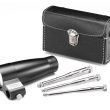
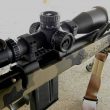
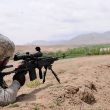
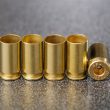
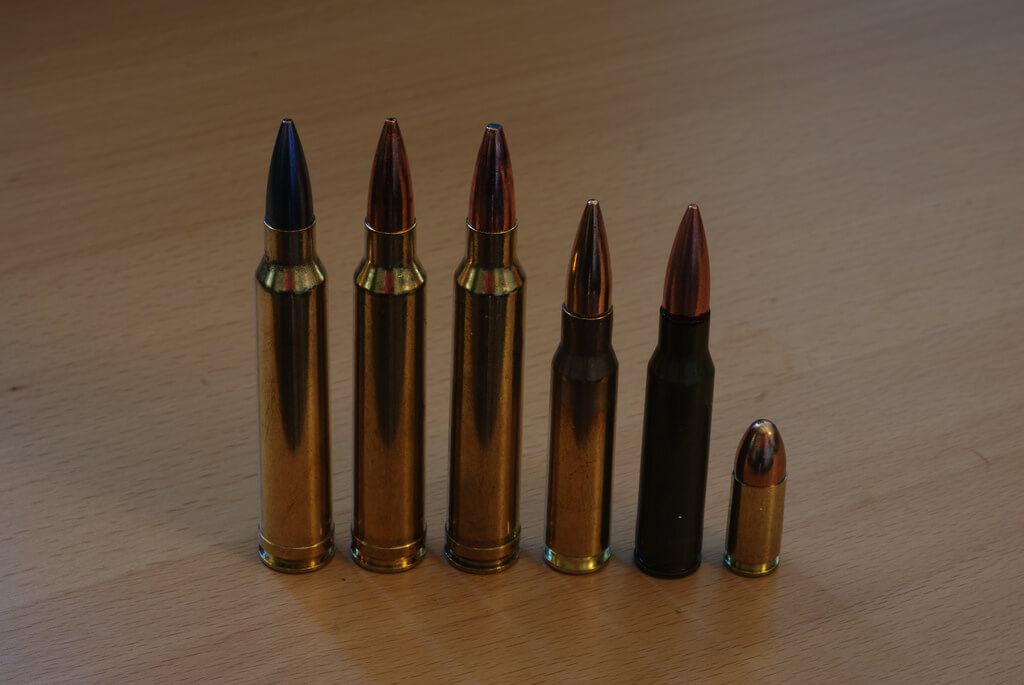
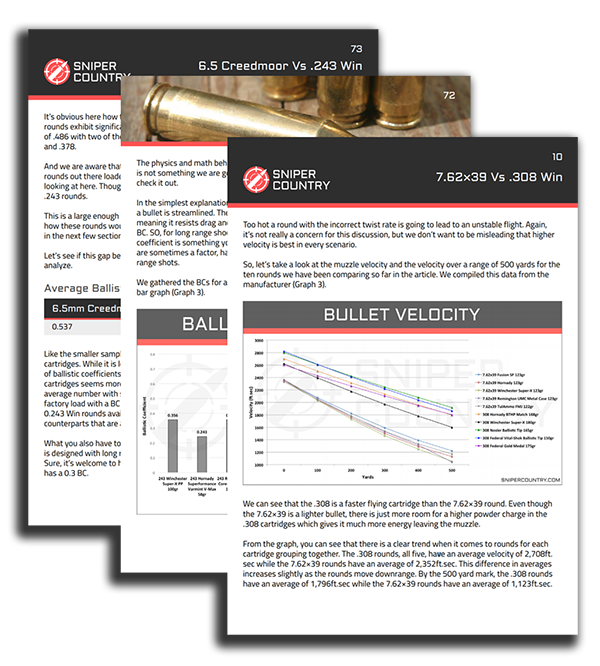

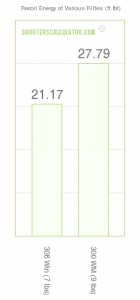
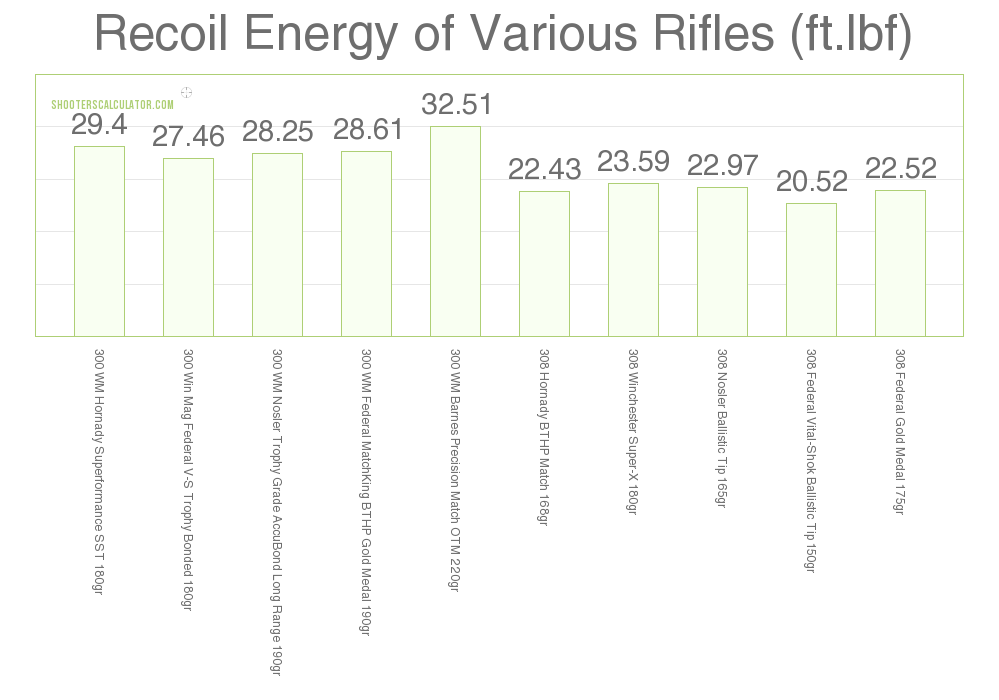
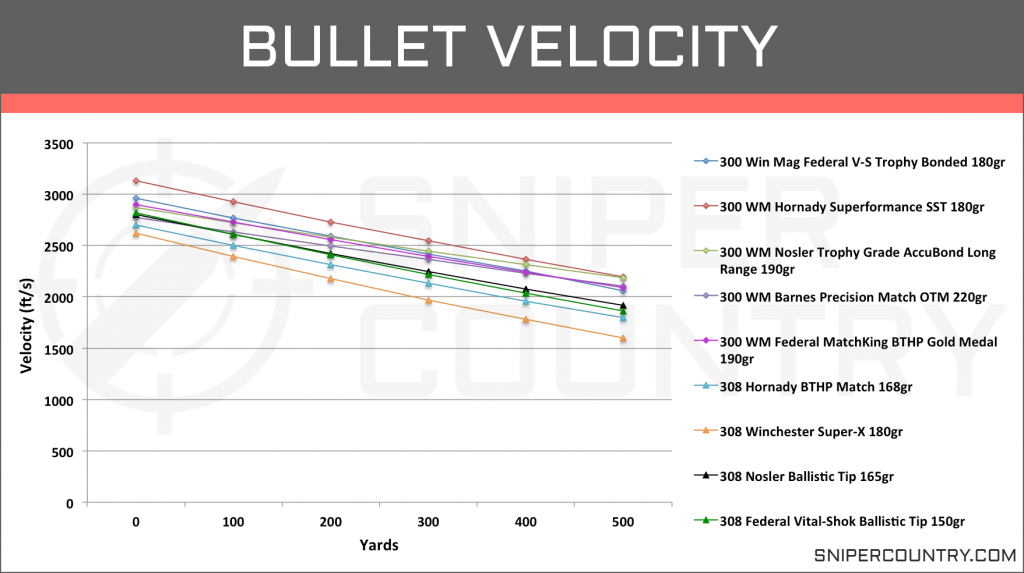
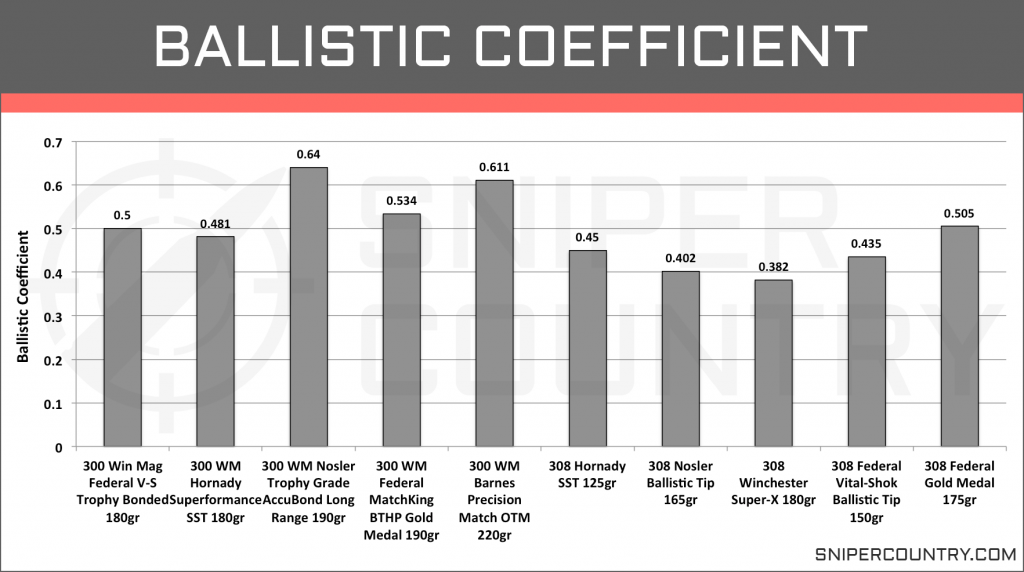
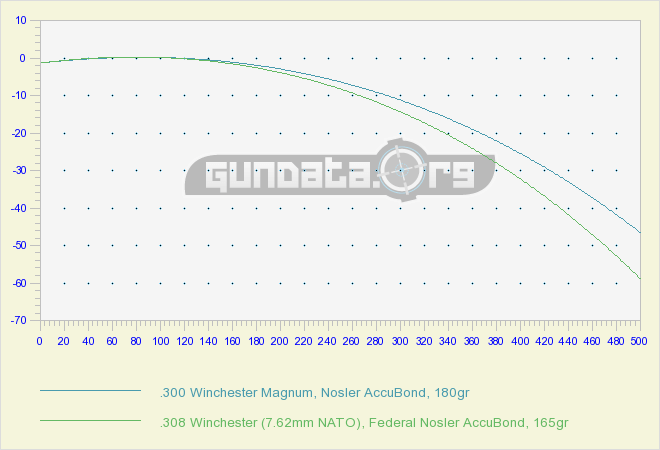
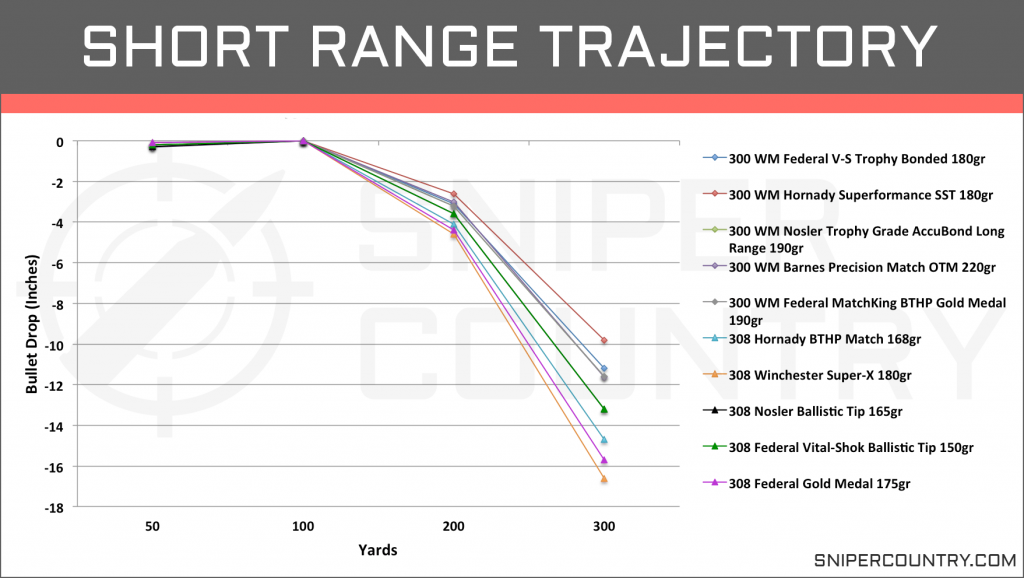
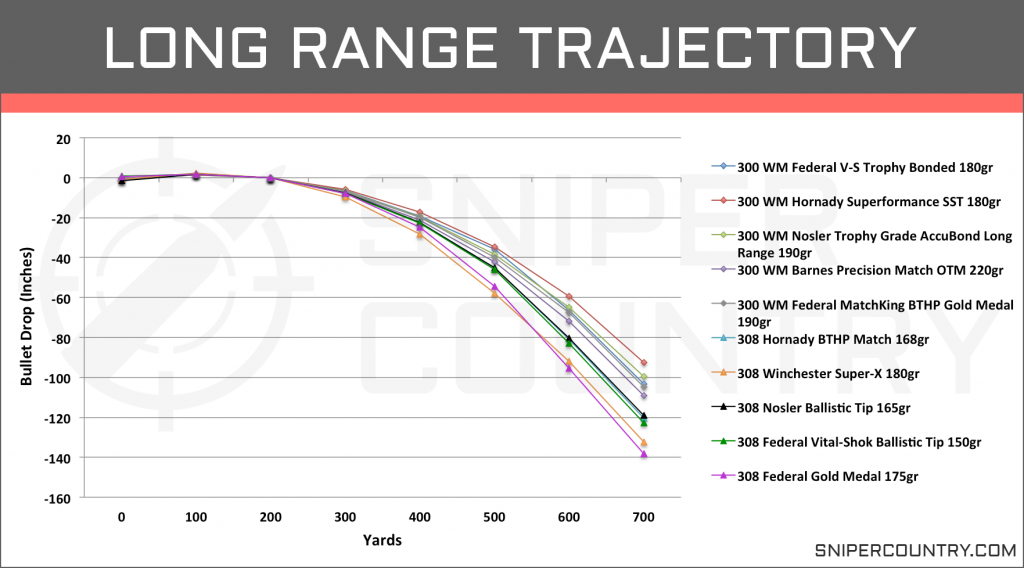
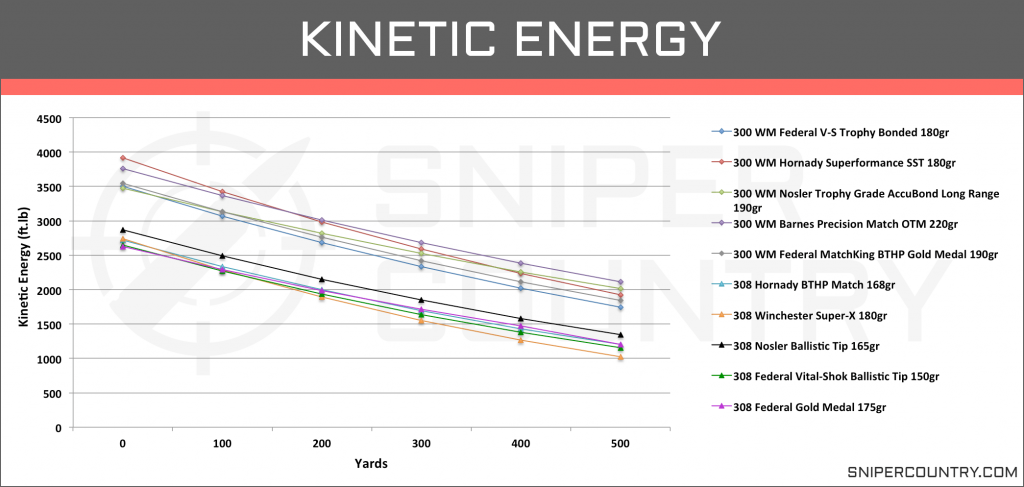
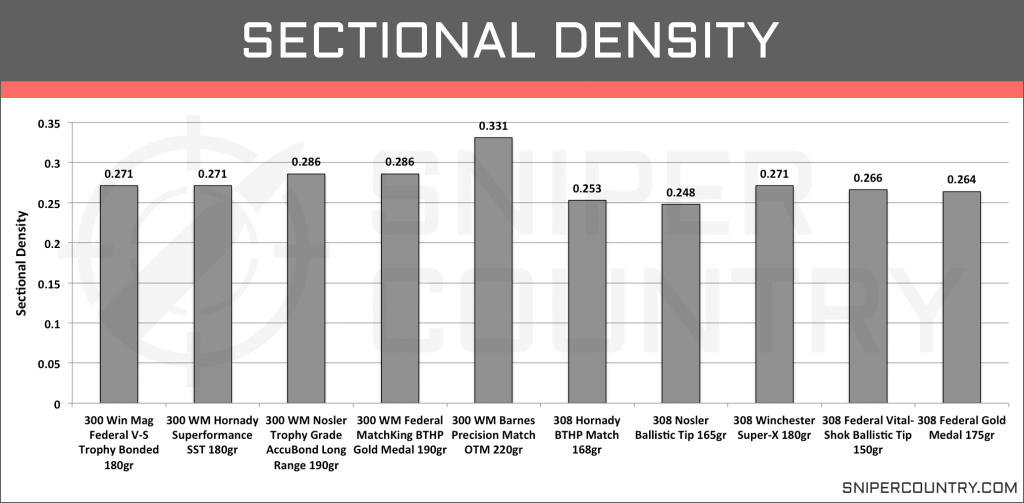
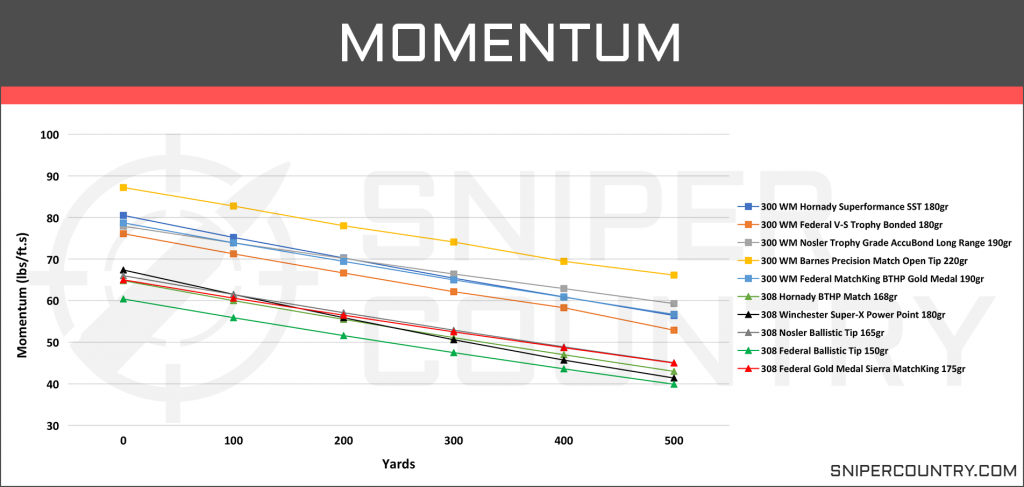
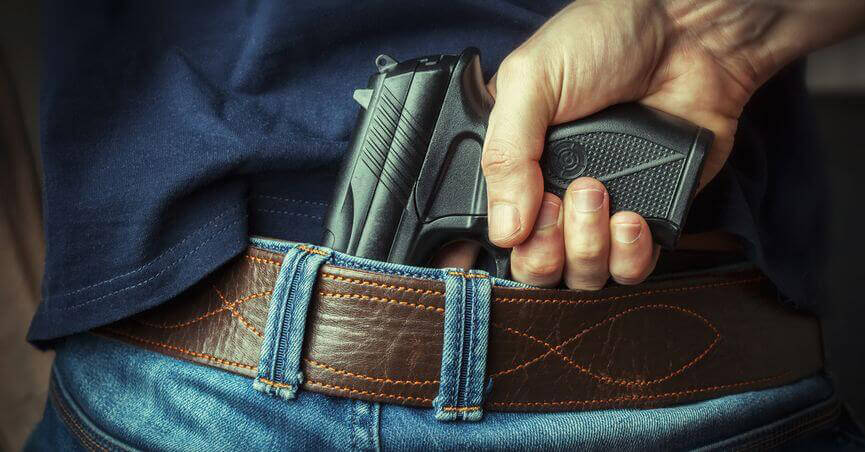
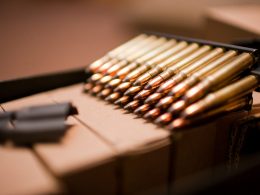

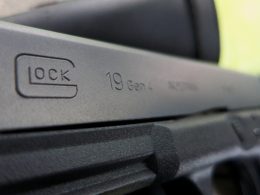
Great article! .308 is great choice for anything less than 500 and as a backup for the .300. If I were to get only 1, the .300 would be the choice.
Wonderful read! I need more information like this. The .308 is the choice for my application.
Well, I have thoroughly enjoyed reading this article. I found it to be the most logically approached, and comprehensively explained scientific look at an age old question. The author knows his stuff, and the universal college instilled logical analysis shows through, with accurate and relavent data sets being used as the empiracal evidence to evaluate each cartridges real world characteristics.
I own both of these calibres, and I can certainly attest to the relevance of the authors focus on recoil.
I shoot a Ruger scout rifle in .308 and a heavy barrel Tikka T3 in .300wm and although the .300 has the edge in every indice measured, I still prefer the .308 for its compact woodlands and bush friendly size, and its significantly lower recoil. Nothing affects accuracy more than the skill of the operator, and not much impacts the operator more than a bad flinch!
Wonderfully informative read.
Excellent review thats turned my painful what new calibre rifle to add into an easy choice for me.
Tomorrow there will be a PTA for a .300 Win Magnum joining my 308.
Fun part will be adding what maker, scope etc.
Thanks for this well rounded, well written article. One of the best i have read in a long list.
Great article, I appreciate the amount of research that went into this well written article. This answers a lot of my questions in a manner that’s easy to understand yet in depth enough to help make a fair comparison. I currently have the 308 in a Ruger Scout Rifle and had been considering a 300WM in the Ruger Guide Gun. Thanks Huston for the work that went into this article.
Could’ve saved everyone 15 minutes by posting this at the top: “When looking at the .300 Win Mag vs .308, we can’t tell you which is the best as we don’t believe there is a definitive answer. “
Excellent unbiased assessment of two great rounds. I own both, and my “Daily Driver” is the .308. The Win Mag is for distance shots. The two BIG differences for me is recoil, and ammo price. That being said I rarely found a gun or a round I didn’t like is some way or another, LOL!